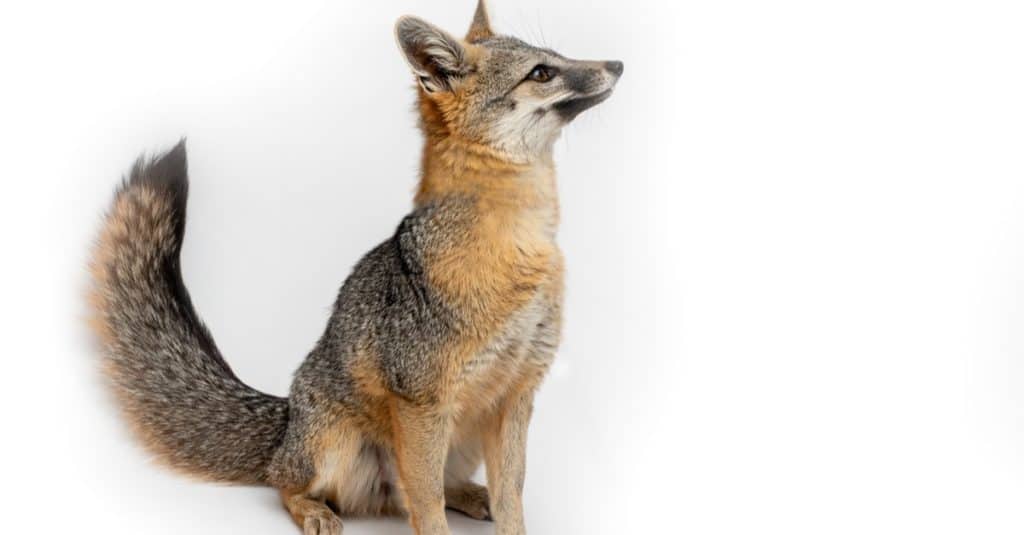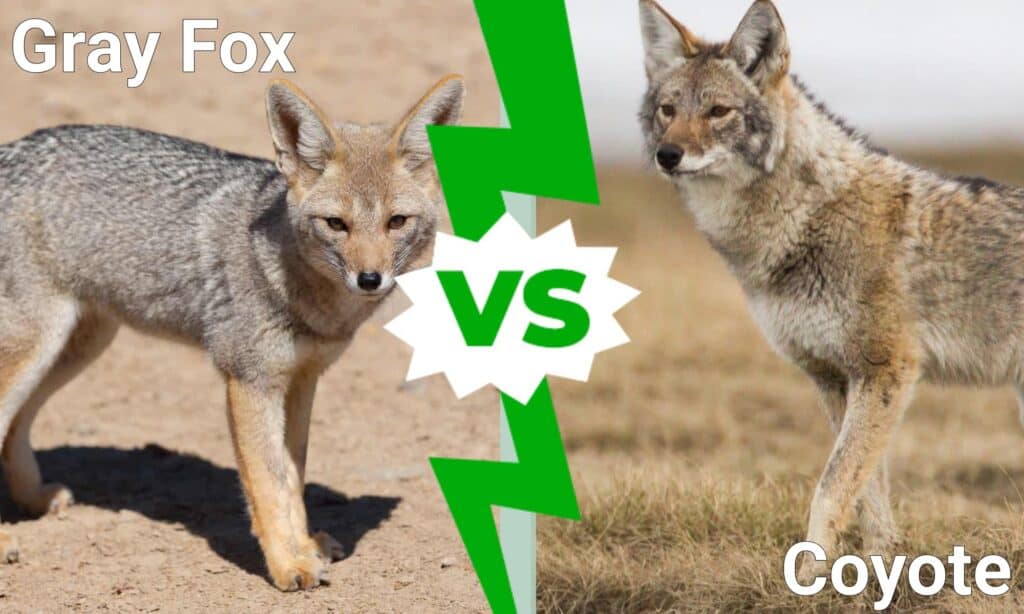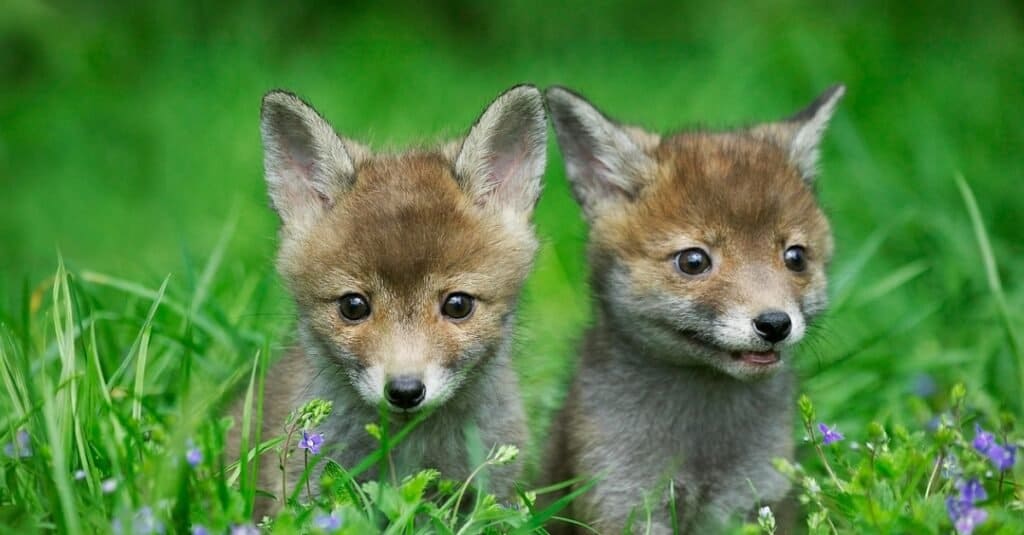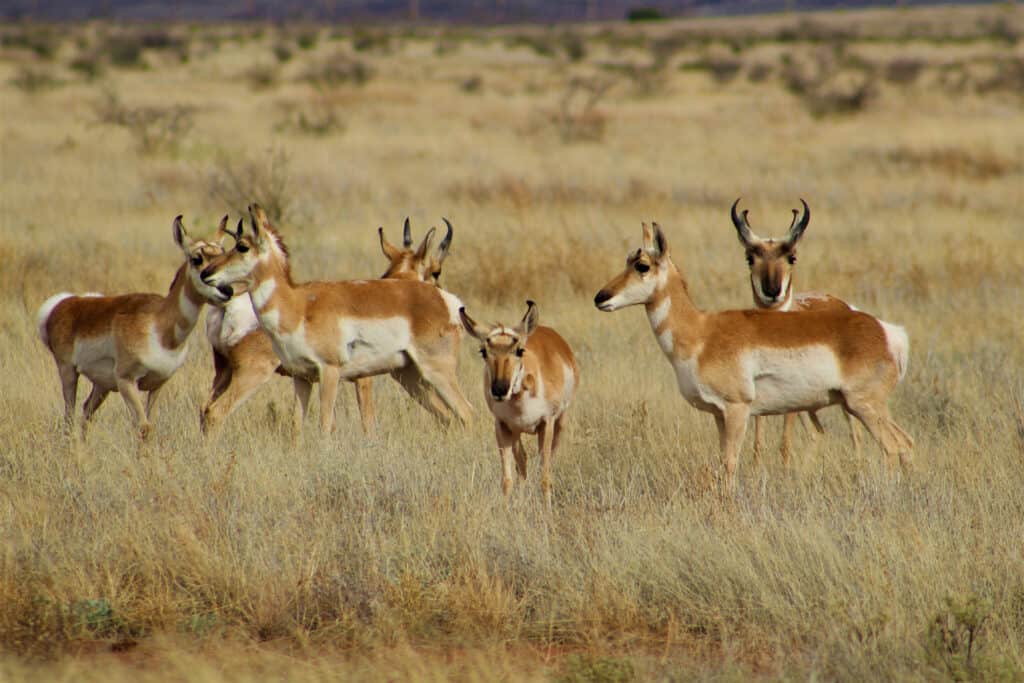What do coyotes, bobcats, and birds of prey have in common? They all love dining on one of Arizona’s most crafty animals, the fox!
Arizona is home to three fox species, and in this article, we’ll uncover everything you need to know about these critters. From where they live to how to identify them, it’s time to become an expert on the fox scene in the Grand Canyon State.
We’ll also give you the best tips so you can see a fox in the wild. With all of its national parks, state parks, and wildlife refuges, there’s no shortage of wildlife viewing opportunities! So, grab your binoculars, and get ready for an animal adventure. Follow along to learn everything you should know about foxes in Arizona.
Foxes in Arizona

Arizona is home to the gray, kit, and red fox species.
©Ste Lane/Shutterstock.com
Arizona is home to the gray, kit, and red fox. The two most common foxes are the gray and kit species. All of these creatures play an important role in the habitat, and they look very different.
If you’ve ever felt like a fox looks like a dog, you’re onto something. Foxes are more closely related to dogs than to cats. They belong to the Canidae family, including dogs, wolves, and other canids. However, foxes have traits that set them apart from cats and dogs.
Gray Fox

Gray foxes have a grayish-brown fur coat and black stripe along the back.
©JayPierstorff/Shutterstock.com
If they have extra food, gray foxes bury it for later. This behavior is called caching, and it’s a sign of how smart these critters are. They even mark the spot where they buried the food by peeing on it.
As their name suggests, gray foxes have a grayish-brown fur coat and black stripe along the back. They’re a bit smaller than red foxes but sport a similarly bushy tail. The big difference is the tail tip. Look closely, and you’ll see the gray fox doesn’t have the same white tip as the red fox.
Kit Fox

The kit fox can be found roaming throughout Arizona.
©Swaroop Pixs/Shutterstock.com
The kit fox is a small, nocturnal fox that inhabits open flats, and they’re great at digging. These little critters rely on kangaroo rats for most of their diet.
Kit foxes are tiny and have sandy fur coats. They’re easy to recognize thanks to their big ears that stand out on their heads. They have a slim body shape. Compared to other foxes, they’re on the smaller side.
Are There Red Foxes in Arizona?

It’s rare to see a red fox in Arizona.
©Giedriius/Shutterstock.com
Red foxes are the most widespread carnivore on Earth, yet barely any of them are in Arizona. Red foxes prefer living in areas with forests, farmlands, and grasslands. They typically measure about 18 to 26 inches at shoulder height and can reach a length of 36 to 46 inches from their snout to the tip of their bushy tails. The chances of seeing a red fox in the Grand Canyon State are slim.
Although rare, red foxes do live in Arizona. And maybe you’ll be lucky enough to spot one! How can you be sure you’re looking at a red fox? Besides the vibrant red coat, look for a bushy tail. Is there a white tip on the tail? Then it’s a red fox.
Red foxes also have pointed ears and a narrow, pointed muzzle. Like most foxes, their legs are dark and have whiskers on them. The whiskers help the fox get its bearings and orient itself, especially when it’s dark.
Where Do Foxes Live in Arizona?

Gray foxes prefer rocky canyons and sometimes use cacti as cover.
©GoodFocused/Shutterstock.com
Where can you spot a fox while you’re in Arizona? Gray foxes prefer rockier canyons, while kit foxes inhabit open areas. And red foxes are almost impossible to spot here.
Here are some of the places you could spot a fox:
- Lake Edge
- Meadows
- Farmlands
- Cities
- Suburban neighborhoods
- Forest edges
- Mountainous region
Foxes can make homes from caves in the desert to mountains. Or they make their homes in burrows, holes in the ground. Sometimes they dig these burrows themselves, and other times they repurpose ones left behind by other animals. They also like to use natural shelters like rock piles and hollow trees.
Who Is Who? Coyote vs. Fox

Was that a fox or coyote that just ran by? The coyote is a famous desert animal in Arizona. It’s known for its intelligence, adaptability, and survival skills. And the gray fox is a quieter relative of the coyote. Gray foxes are the only canid regularly climbs trees. They hunt and sometimes sleep in trees.
Since foxes and coyotes live throughout Arizona, learning to tell them apart will make your wildlife watching much more enjoyable. For starters, coyotes are generally larger than foxes. Coyotes can weigh between 15 to 25 pounds, while foxes, depending on the species, can range from 4 to 9 pounds.
The tails are another good giveaway. Coyotes have long, bushy tails with black tips. Foxes also have bushy tails, but they are typically more slender and may have a black stripe running along the top. And if it’s a red fox, the tail tip’s white.
Notice how pointy the face is. The pointier it is, the more likely you’re looking at a coyote.
Coyotes have pointy faces with large ears and a more slender appearance. Foxes, depending on the species, may have slightly different facial features. However, they often have a more rounded face with smaller ears.
Both creatures can be seen running around the forests of Arizona. Coyotes live in small family groups and have a central core area for den sites. They mark their territory using scent markings and scats. When you know what fox poop looks like, you’ll become an expert at detecting fox activity.
Fox Babies in Arizona

Fox babies are called kits, of which there can be seven in a single litter.
©iStock.com/slowmotiongli
What’s better than seeing a fox in Arizona? Seeing a fox family! Female foxes, called vixens, can have a lot of babies at once.
Spring is the best time to see fox babies (called kits). They can give birth to between three and seven but usually have around four. Gray foxes breed in late winter, and the pups are born in March or April. They often den in boulder piles or natural cavities. And kit foxes can survive without free water and use dens year-round. They change dens frequently, and females move into family dens to prepare for new pups.
The kit fox species use dens to regulate their body temperatures and provide a safe place for their young. Females give birth to litters of five to seven kits after mating season, but the kits stay inside the dens until they are around four months old. They become independent at around six months old.
Once they leave the dens, foxes typically stick with their families for life. Sometimes parents pass on a den generation after generation, especially if it’s a good spot. And while they’re willing to share real estate, foxes are a lot different about their food.
When the young embark on their own, finding food is up to them. Foxes hunt individually, primarily preying on cottontails, rodents, birds, and animal eggs. A lot more animals lay eggs than you might think.
Fox Viewing Areas

The Grand Canyon National Park offers tons of wildlife viewing opportunities.
©Wenbo/Shutterstock.com
Do you want to see wild animals in the wild? Then Arizona is the right place to be. Some say seeing a fox has special symbolism or spiritual interpretations. Others simply love seeing animals in action.
Here are a few spots where you can spy a fox, along with other exciting animals:
- Grand Canyon National Park
- Saguaro National Park
- Arizona-Sonora Desert Museum
- Bearizona Wildlife Park
- Tonto National Forest
- Riparian Preserve at Water Ranch
- Petrified Forest National Park
- Blue River Route in Arizona’s Apache-Sitgreaves National Forests
- Grasslands Wildlife Area
- Chiricahua National Monument
Arizona has six national forests, 22 national parks, monuments, and many wildlife refuges. But that’s not all! Hidden among the landscapes are approximately 30 state-run wildlife areas, each offering a fantastic experience for observing wildlife.
Sipe White Mountain Wildlife Area

The Sipe White Mountain Wildlife Area in Arizona offers a hummingbird festival.
©Keneva Photography/Shutterstock.com
Among the state-run wildlife areas is the Sipe White Mountain Wildlife Area, located along the eastern border of north-central Arizona. If you want to see a fox and love all things birds, this is your spot.
The Sipe White Mountain wildlife area is renowned for its significant population of hummingbirds. During the July High Country Hummers festival, visitors can witness the captivating spectacle of four hummingbird species migrating through the area. The species include the broad-tailed, rufous, calliope, and black-chinned hummingbird.
The Blue River Route in Arizona’s Apache-Sitgreaves National Forests

Rocky Mountain
bighorn sheep
frequent the Blue River Area in Arizona.
©John Raptosh/Shutterstock.com
The Blue River Area offers wildlife viewing opportunities, including foxes. This area is also known for being under-birded, providing interesting birdwatching experiences. Bird enthusiasts can explore diverse habitats and have the chance to spot notable species such as the greater pewee, hepatic tanager, common blackhawk, and Mexican jay.
There are convenient campgrounds along the route to accommodate visitors, such as Upper Blue Campground and Blue Crossing Campground. These campgrounds offer facilities for visitors to rest and recharge before continuing with a day of wildlife viewing. Along with foxes and birds, you might enjoy sightings of mule deer, white-tailed deer, coyotes, big horn elk sheep, and more.
The diverse habitats in the Blue River area contribute to its rich biodiversity. From river riparian to ponderosa pine and pinyon pine, as well as juniper woodlands, there are a lot of ecosystems to explore.
Grasslands Wildlife Area

Pronghorns frequent the Grasslands Wildlife Area in Eagar, AZ.
©Charles Lemar Brown/Shutterstock.com
The Grasslands Wildlife Area by Eagar, AZ, offers a three-mile hiking trail of moderate difficulty. It comprises juniper woodland, grassland, and ponds, providing diverse habitats for wildlife. Visitors have a high probability of spotting pronghorn antelope, squirrels, chipmunks, rabbits, elk, coyotes, badgers, skunks, and gray foxes. The trees are one of the biggest attractions for Arizona’s wildlife.
Final Thoughts
On our Arizona animal journey, we learned that the Grand Canyon State is home to three fox species: red, gray, and kit fox. Red foxes are rare and hard to spot. But gray and kit fox species are easy to find!
Gray foxes have a grayish-brown coat and are famous for climbing trees. While kit foxes are the tiniest species but have the biggest carnivorous appetite. They’re the ones with giant ears who love eating kangaroo rats.
While you’re in Arizona, keep an eye out for these fox species roaming around. And if you’re visiting in the spring, maybe you’ll see a fox family.
The photo featured at the top of this post is © Alexander Lukatskiy/Shutterstock.com
Thank you for reading! Have some feedback for us? Contact the AZ Animals editorial team.






